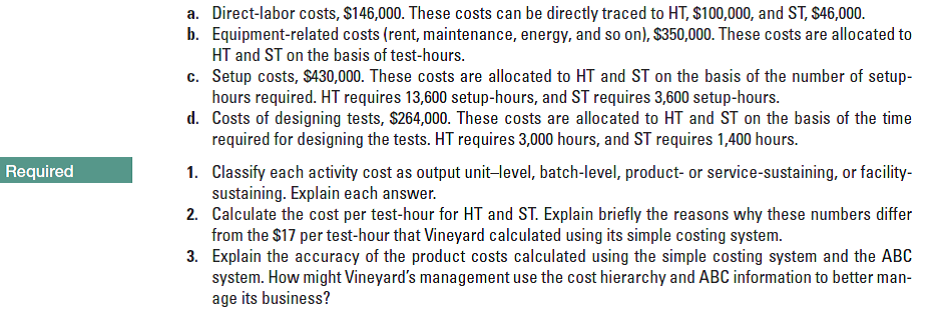a. Direct-labor costs, $146,000. These costs can be directly traced to HT, $100,000, and ST, $46,000. b. Equipment-related costs (rent, maintenance, energy, and so on), $350,000. These costs are allocated to HT and ST on the basis of test-hours. c. Setup costs, S430,000. These costs are allocated to HT and ST on the basis of the number of setup- hours required. HT requires 13,600 setup-hours, and ST requires 3,600 setup-hours. d. Costs of designing tests, $264,000. These costs are allocated to HT and ST on the basis of the time required for designing the tests. HT requires 3,000 hours, and ST requires 1,400 hours. 1. Classify each activity cost as output unit-level, batch-level, product- or service-sustaining, or facility- sustaining. Explain each answer. 2. Calculate the cost per test-hour for HT and ST. Explain briefly the reasons why these numbers differ from the $17 per test-hour that Vineyard calculated using its simple costing system. 3. Explain the accuracy of the product costs calculated using the simple costing system and the ABC system. How might Vineyard's management use the cost hierarchy and ABC information to better man- age its business? Required
Process Costing
Process costing is a sort of operation costing which is employed to determine the value of a product at each process or stage of producing process, applicable where goods produced from a series of continuous operations or procedure.
Job Costing
Job costing is adhesive costs of each and every job involved in the production processes. It is an accounting measure. It is a method which determines the cost of specific jobs, which are performed according to the consumer’s specifications. Job costing is possible only in businesses where the production is done as per the customer’s requirement. For example, some customers order to manufacture furniture as per their needs.
ABC Costing
Cost Accounting is a form of managerial accounting that helps the company in assessing the total variable cost so as to compute the cost of production. Cost accounting is generally used by the management so as to ensure better decision-making. In comparison to financial accounting, cost accounting has to follow a set standard ad can be used flexibly by the management as per their needs. The types of Cost Accounting include – Lean Accounting, Standard Costing, Marginal Costing and Activity Based Costing.
ABC, cost hierarchy, service. (CMA, adapted) Vineyard Test Laboratories does heat testing (HT) and stress testing (ST) on materials and operates at capacity. Under its current simple costing system, Vineyard aggregates all operating costs of $1,190,000 into a single overhead cost pool. Vineyard calculates a rate per test-hour of $17 ($1,190,000 ÷ 70,000 total test-hours). HT uses 40,000 test-hours, and ST uses 30,000 test-hours. Gary Celeste, Vineyard’s controller, believes that there is enough variation in test procedures and cost structures to establish separate costing and billing rates for HT and ST. The market for test services is becoming competitive. Without this information, any miscosting and mispricing of its services could cause Vineyard to lose business. Celeste divides Vineyard’s costs into four activity-cost categories.

Trending now
This is a popular solution!
Step by step
Solved in 4 steps with 3 images






